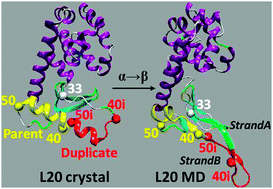Molecular dynamics study of an insertion/duplication mutant of bacteriophage T4 lysozyme reveals the nature of α → β transition in full protein context†
Abstract
An α → β transition underlies the first step of disease causing amyloidogenesis in many

* Corresponding authors
a
Department of Chemistry, Indian Institute of Technology Bombay, Powai, Mumbai 400 076, India
E-mail:
sasidhar@chem.iitb.ac.in
An α → β transition underlies the first step of disease causing amyloidogenesis in many

 Please wait while we load your content...
Something went wrong. Try again?
Please wait while we load your content...
Something went wrong. Try again?
H. Kaur and Y. U. Sasidhar, Phys. Chem. Chem. Phys., 2013, 15, 7819 DOI: 10.1039/C3CP44327B
To request permission to reproduce material from this article, please go to the Copyright Clearance Center request page.
If you are an author contributing to an RSC publication, you do not need to request permission provided correct acknowledgement is given.
If you are the author of this article, you do not need to request permission to reproduce figures and diagrams provided correct acknowledgement is given. If you want to reproduce the whole article in a third-party publication (excluding your thesis/dissertation for which permission is not required) please go to the Copyright Clearance Center request page.
Read more about how to correctly acknowledge RSC content.
 Fetching data from CrossRef.
Fetching data from CrossRef.
This may take some time to load.
Loading related content
